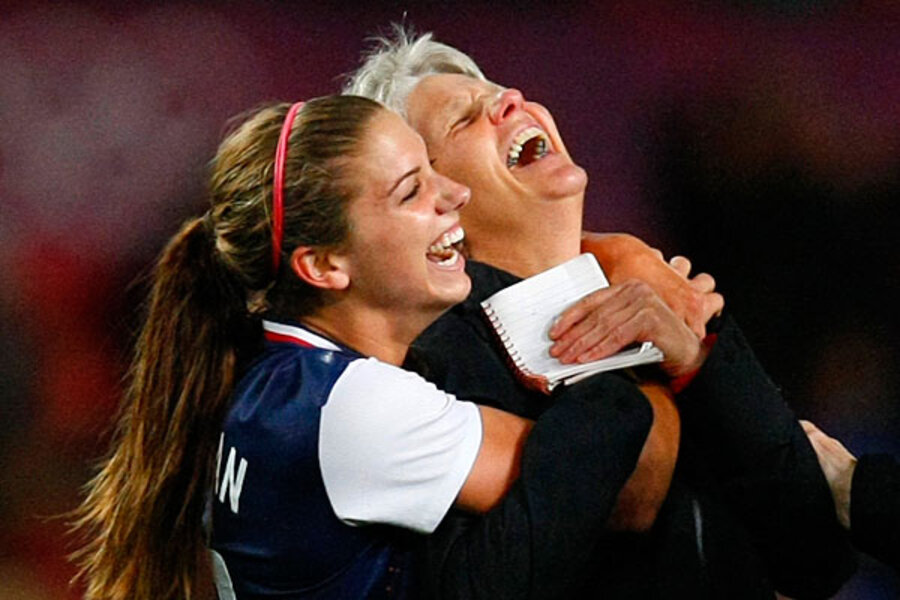Olympics soccer: Is Alex Morgan the next Mia Hamm? Teammates gush.
Loading...
| London
Heather O'Reilly has just made a remarkable statement. It is a media summit before the Olympics began, and she is talking about American soccer forward Alex Morgan.
"She is probably the best natural goalscorer I've played with," she says.
Bear in mind, at the 2004 Olympics, Ms. O'Reilly played with Mia Hamm, the all-time leading goalscorer in women's soccer history.
Then, earlier this week after a training session, No. 2 all-time leading scorer Abby Wambach took Ms. Morgan aside. "She said she didn't think she had had a partner in crime" – in this case, goalscoring – "since Mia Hamm in 2004," Morgan said at a press conference Wednesday.
There's that Mia Hamm name again, and Morgan's name right beside it.
There's good reason.
As the Americans prepare to face Japan in the gold medal final of the London 2012 Olympics at historic Wembley Stadium Thursday, there is no question this is still Wambach's team. Her presence is the central point around which the entire American team spins.
Morgan's contribution
But there is also no doubt that Morgan is Wambach's second half, forming the most lethal striking pair in women's soccer and the face of the future of the game.
US coach Pia Sundhage was asked Wednesday about her team having conceded five goals combined to France and Canada this tournament. Her response was that America has scored eight – and none more important than Morgan's header with 30 seconds left in the semifinal against Canada, breaking a 3-3 tie.
Indeed, the transformation of Morgan – as well as winger Megan Rapinoe, who scored twice against Canada – into elite soccer players during the past year has covered many of the American team's faults. Without them, the US would almost certainly be playing for bronze today.
But the two mean something more to the development of women's soccer in America than a potential Olympic gold in London.
A new generation
In Rapinoe and Morgan, the US has the beginnings of a new generation that matches the traditional American strengths of fitness, speed, and physical strength with the greater degree of sophistication seen in rising soccer nations like Japan, France, and Germany.
America's strengths have guided it to unprecedented success on the world stage, but Canada nearly won its semifinal with the US – a game in which it was nearly run off the pitch – because it was tactically smarter and because it had Christine Sinclair, a player whose skill the US defense could not cope with.
Rapinoe's right foot is simply a national treasure – think of her as the David Beckham-in-waiting of American women's soccer, whipping in inch-perfect crosses from anywhere on the field.
For her part, Morgan is a quantum of pure energy. But it is not the random running of admirable endeavor. It almost always has a purpose, and it is why she has emerged as such an integral part of the American future.
Take a moment, when the ball is elsewhere, to watch her. When her teammates have the ball, she is constantly probing the opposing defense, trying to find the tight channels through which she can slip for a free shot at goal. When opposing defenders have the ball, she is chasing them down, trying to get it back so that America can maintain its typical vise-like pressure on opposing teams.
In short, she never, ever gives her defenders a moment's peace.
Combine that with Wambach, who lacks only armor plating and a turret, and what are opposing defenses supposed to do? Call for reinforcements, mostly, which results in teams packing as many players as close to their own goal as possible, and then hoping to break with quick counterattacks. (Canada did this to great effect.)
America's response has been to launch long ball after long ball at opponents, hoping to catch them before the defense has been packed with bodies. It is a tactic whose only hope in success is in Wambach's extraordinary head and Morgan's extraordinary movement, because it means the duo is essentially left alone with the ball as the rest of the American midfield races to catch up.
Love for Morgan
But Morgan's uncanny ability to find free space, often amid multiple defenders, and pick up Wambach's scraps is why her teammates are quick to laud her.
"She is always ready for an opportunity," says Tony DiCicco, the former national team coach, who brought Morgan into the US youth team picture when he was coach of the under-20 national team in 2008.
And she's not bad when that opportunity comes. In last year's World Cup, she scored two of the most expertly taken goals of the tournament, a delicate chip in the semifinal against France, and then an inch-perfect blast to the far corner in the final against Japan.
Which is why O'Reilly was gushing.
"Alex is one of the most total packages," says DiCicco.
Coach Sundhage admits that the US might not be able to get away with its long-ball game against Japan. Long passes are low percentage, meaning you often lose possession, and Japan – perhaps the most technically adept team in women's soccer – is unlikely to gift it back quickly. "The best way to defend against Japan is to keep the ball," she said.
Then again, with the unique and complimentary skills of Wambach and Morgan up front, she said, "They are looking good, so I totally understand if that ball is played."






